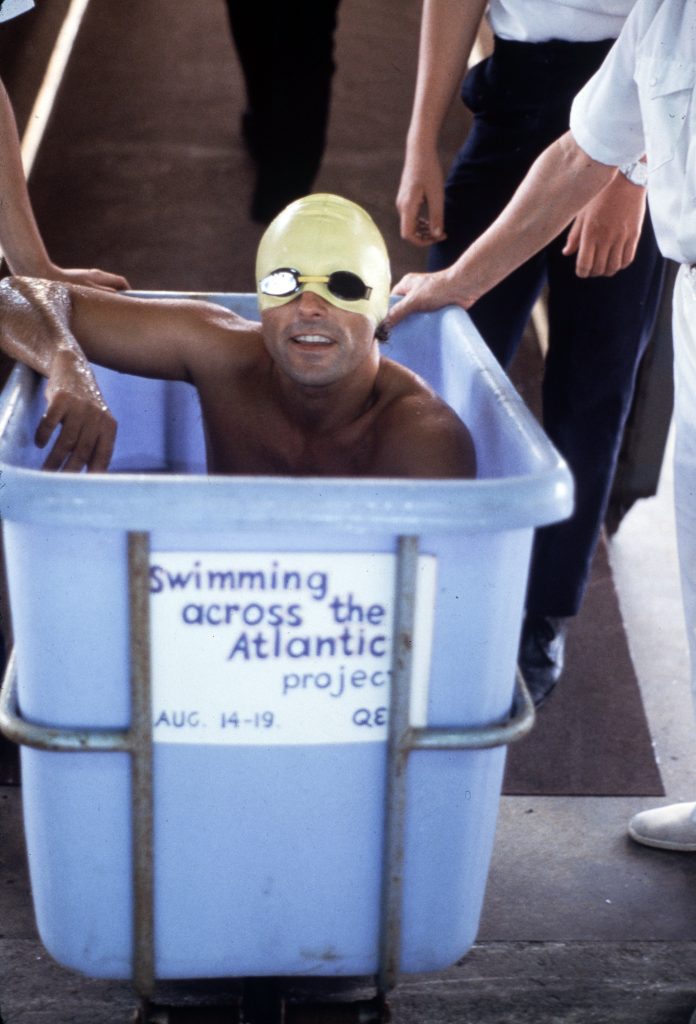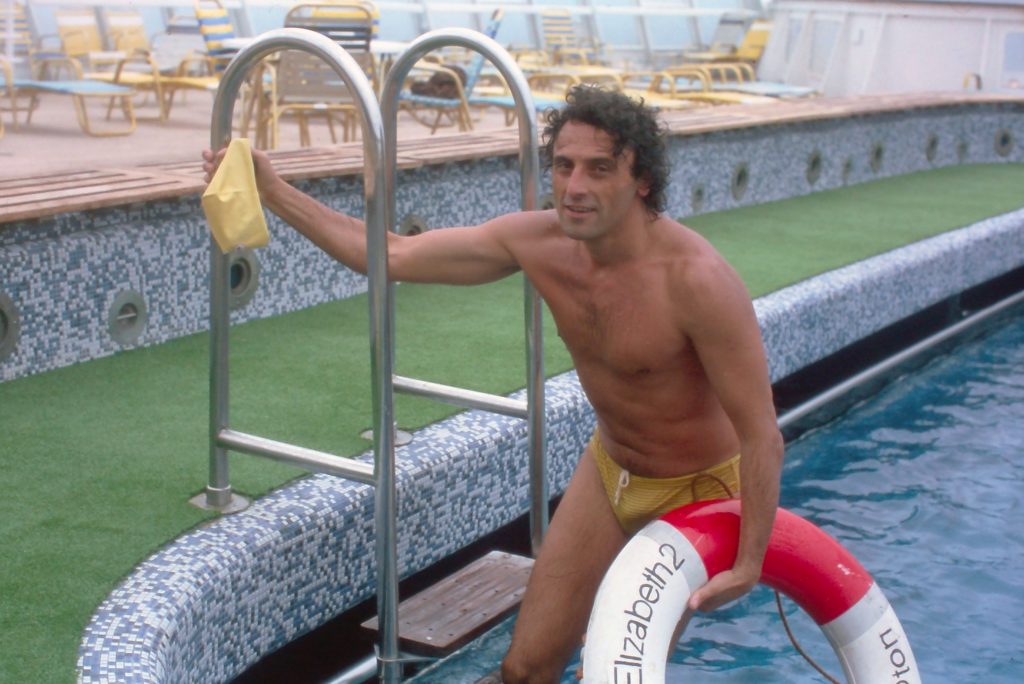August 14th-19th, 1982, Queen Elizabeth 2
(From the diary, August 15th, 1982)

Eight o’clock in the morning it rains in stop and starts. The two open-air swimming pools are half-full because the pumps are out of order, as they have been out of use for 3 or 4 months. But like a diligent office worker, devoted to my duty, I go into the water. 14 degrees centigrade, pure ocean water. I resist thanks to my 3 years training, then I protest, and finally I feel the heating system beginning to belch warm and… rusty water. It’s not dangerous, you only become gradually orange.

An optimistic painter may well regard this as a problem of chromatics. Knowing that I would have to swim for hours and having a relatively slender constitution, over a period of two years I have worked out a very slow butterfly style which allows a correct circulation and an equilibrated relationship between speed, heat and effort.
Last year, for a period of two months, I swam at 5.30 am every morning in an Olympic swimming pool in Bronx, together with the real ‘monsters’ of the American competitions. With the assistance of Dr. Jane Katz – a world champion and author of the book ‘Swimming for Total Fitness’ – I think I have improved.
Cutting a good figure is almost always an aesthetic problem. The swimming pool of the Queen Elizabeth II. Back and forth until midday, and then a break of two hours before resuming the last four hours swimming of the day.
A few bumps on the edge of the pool because the water picks up the sea waves and makes them stronger, since the pool is at a higher level. Not that bad to be my first experience. Considering that it is my first swim on board and my first trip on a liner. And what a liner!
August 17th, 1982.
The article on the project has come out today. A four-page newspaper is printed on board every day. It contains world news, the day’s program, a cultural article, stock exchange news on the fourth page. The article also announces a radio interview relayed to each cabin. During that interview a strange proposal was made: why not swim during Queen Elizabeth II’s annual round the world trip?
I had never thought in terms of anything so ambitious. The Atlantic was enough for me. Then they broadcasted my record ‘Swimming across the Atlantic’. End of the program, and I went back to my usual work in the swimming pool. It was announced that in order to receive the diploma of ‘Atlantic Crosser’ from my ‘office’, it was necessary to swim for at least one minute with me.
Signed and dated. First children arrived to ‘explain’, to me that a minute isn’t enough. Then the fathers, the mothers and a few grandfathers arrived, as well. In the afternoon there was a storm, with gusts of wind; in compliance with the regulations, they emptied the two external swimming pools and I had to go down to the 6th and 7th deck, to the two other swimming pools.

August 18th, 1982.
Finally, sun and warm water. Lots of people around the office. Lots of diplomas. While I am swimming, I remember that only two months ago the ‘art’ section of the New York Times had a ready-for-printing press release of mine about abandoning the whole project for precise reasons:
‘She was the only one who remained to unite my old continent with America, carrying passengers who looked for pleasure or were nostalgic, formerly touristic. Not long ago.
‘And now I can see the swimming pool of the liner, without water, buried under the weight of the helicopters. I see this on the front pages of the newspapers… And as I close my eyes, in a flash I see a very small torpedo, certainly of unknown origin, looking for its publicity target. A one-time tourist target. And without realizing it I feel that my only work tool – this liner – is in danger.
I recall that in ancient times – times which on this account seem to me to be more glorious than ours – all activities of war were interrupted for cultural or sporting events… The Olympic Games of ancient times.
Today, my work was oriented on capturing as in a photograph an image of day-to-day existence, a cruise and all the surroundings, these times of ours with their contradictions and their trivialities…

In peace time. But war has a logic of its own and it claims the only truth it has: the truth of the burnt out photographic plate. I am wondering whether we consider some of the works of the past as miraculous, only on account of their intrinsic beauty, or also because they have managed to escape from the furies of the calamities of the world. And I am also wondering if I have any reason or any right, as an ordinary artist, to continue and finish a work that has been started, with no specific utility in itself. It is useless according to the ‘utility and the necessity’ proclaimed by the army commanders involved in the military operations.
I realize that these are rhetorical questions. But if from some corner of the globe I was to get some support on this task, even if it were only faint like the hint of a smile, I may be very proud of having given my poor contribution and of having given expression to the immense generally felt desire to return to normality, also on a tourist level (June 1982, New York).
The text was not published because in the meantime fortunately the war ended.

August 19th, 1982, port of New York.
At 6 am the liner stops suddenly, a small boat with pressmen and TV crews comes alongside and they embark on the Queen Elizabeth II. The sun keeps its early morning promise.
A beautiful dawn, worthy of a photograph, we are about to arrive.
The first officer has placed at my disposal a container on wheels, filled with warm water, near to the general exit for passengers. The liner comes alongside, we are in the heart of Manhattan. All is according to the plan. On board we begin the press conference and the Captain gives a long speech. Helicopters with television cameras are circling overhead, like in Southampton. Glasses and the uncorking of bottles again.
My project is going according to its plan, too. Inside the container, pushed by two officers, I slowly cross the deck and arrive in the midst of the New York customs officials, all dumbfounded.
They explain to them that the first man who has swum across the Atlantic goes through the customs like all the other passengers[1]…
[1] Misheff, A., Swimming across the Atlantic, Milan, Mazzotta ed., 1982.